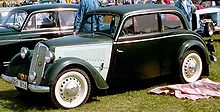IFA F8
| IFA | |
|---|---|
| F8 | |
| Production period: | 1949-1955 |
| Class : | Small car |
| Body versions : | Sedan , station wagon , cabriolet , pickup |
| Engines: |
Gasoline engine 0.7 liters (20 HP (15 kW)) |
| Length: | 3900-4000 mm |
| Width: | 1480 mm |
| Height: | 1480 mm |
| Wheelbase : | 2600 mm |
| Empty weight : | 750-900 kg |
| Previous model | DKW F8 |
| successor | EEZ P70 |

The IFA F8 is a passenger car of the Industrieverband Fahrzeugbau der DDR, which was manufactured as a further development of the almost identical DKW F8 between 1949 and 1955. The F8 is part of the series of DKW front-end cars that began in 1931 with the F1 , the first series vehicle in which front-wheel drive was successfully used.
history
The Audi works in Zwickau , which from 1945 initially had orders to carry out repair work for the Soviet Military Administration in Germany (SMAD), were planning to resume new car production based on the pre-war DKW F8 as early as 1946. The first newly built vehicle was presented at the Leipzig trade fair in 1947 under the name "DKW-IFA F8" . In 1948, three prototypes were presented to the SMAD in Berlin-Karlshorst . Series production began a year later. However, they wanted to end the production of this traditional model very soon. In 1953, however, extensive foreign orders prompted the continuation of production, with some detail improvements, such as a modified front wheel suspension, being implemented. Other convertible models were added to the range of models. Around 25,000 IFA F8s had rolled off the production line by the time production was finally stopped in 1955. The production of replacement bodies for the station wagon continued in Meerane until 1964, whereby the work time was more than twice as high as for the production of a Trabant station wagon body.
technology
engine
| design type | 2-cylinder two-stroke - gasoline engine , installed in series across the front |
| Displacement | 690 cc |
| Maximum power | 20 HP (15 kW) at 3500 min -1 |
| Max. Torque | 49 Nm at 2500 rpm |
| Top speed | 85 km / h |
| fuel | Mixture 1:25 |
| Consumption per 100 km | 7.5–8 l |
Source:
The IFA F8 had the 0.7-liter engine of the DKW master class, which has been driving the DKW front-end cars largely unchanged since 1933. It was produced in the Chemnitz engine factory after the war . The technology of the two-stroke engine with Schnürle reverse flushing installed behind the front axle included thermosiphon cooling and the flat-flow carburetor H30 from the Berlin carburetor factory . The power was transmitted to the front wheels via a three-speed gearbox (with lockable freewheel in all three gears). The F8 was started with Dynastart - a combination of starter and alternator.
The engine was used with a different direction of rotation and increased power in the EEZ P70 and served as the basis for the Trabant engine, which was produced until 1990 .
Body styles
| limousine | Station wagon | Cabriolet | delivery trucks | |
|---|---|---|---|---|
| length | 3.90 m | 4.00 m | 3.90 m | |
| width | 1.48 m | 1.48 m | 1.48 m | |
| height | 1.48 m | 1.48 m | 1.48 m | |
| Weight | 750 kg | 780 kg | 900 kg | |
| Perm. total weight | 1120 kg | 1170 kg | 1290 kg | |
| Base price | 8,415 DM | 9,400 DM | 11,325 DM |
Source:
While the original, the DKW F8, was only manufactured as a delivery van , sedan and convertible , the new IFA F8 was also given a body as a station wagon and flatbed truck and could thus be used in a variety of ways. The body was made of wood and was covered with synthetic leather. Sheet steel was used for the fenders and the bonnet including the radiator grille. The convertible body was completely covered with sheet metal. From February 1953, hoods and other parts of the convertible were made of thermosetting plastic (cotton-fiber-reinforced phenolic resin ). Luxury convertibles and convertibles with special bodies from the Dresden bodywork factory were first presented at the Leipzig trade fair in 1953.
The wheels were individually suspended at the front, on a rigid axle at the rear, and sprung at the front and rear with transverse leaf springs with hydraulic lever shock absorbers. There were mechanical duplex brakes on all four wheels . The steering was a rack and pinion steering system with straight teeth.
Web links
Individual evidence
- ↑ a b Motor vehicles at the Leipzig trade fair in 1953. In: Motor vehicle technology 11/1953, pp. 342–344.
- ↑ a b The IFA F8 page
- ↑ How long will obsolete products continue to be produced? In: Motor vehicle technology 10/1964, pp. 362–363.
- ↑ The IFA F8 page
- ↑ The Dynastartanlage in the DKW car F8. In: Motor Vehicle Technology 4/1951, pp. 89–91 and 5/1951, pp. 111–113.
- ↑ a b German automobiles




